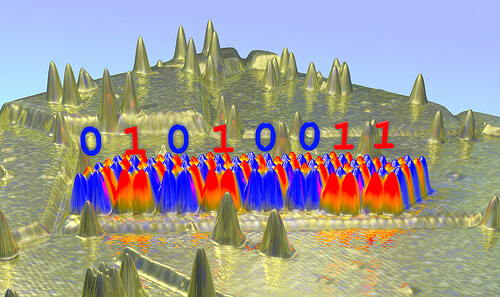The memory at the atomic level will be 100 times denser and more compared to disks and memory chips known today

Scientists at IBM's research laboratories in California have for the first time successfully presented technology for magnetic storage of information on just 12 atoms.
The number of atoms required to store a single bit in IBM's new technology is significantly lower than that known today, in hard disks and flash memory: the existing storage devices consume about a million atoms for each single bit of data. The possibility of making changes in the magnetic nature of the material by focusing on the level of the individual atoms, may pave the way for building smaller, faster and more economical storage devices in terms of current consumption.
Silicon transistor technology has become cheaper, denser and more efficient over the years. However, basic physics shows that it will not be possible to maintain the rate of miniaturization known to us in the last decades in the long term: new basic approaches are needed in order to ensure a continuation of technological development.
The IBM scientists adopted a completely new approach, and set out to build the smallest unit for data storage, at the level of individual atoms. The storage technology born in this experimental process is 100 times denser compared to what is common in the drives and volatile memory chips we know today. The nanostructures that the scientists at IBM are building, while each time placing a single atom in its designated place, are based on an unusual form of magnetism, known as "antiferromagnetism", in which rows of magnetic molecules alternately line up in an array of poles in opposite directions.
איך זה עובד?
The most basic piece of information that a computer can understand is one bit of data (Bit). Similar to how a light can be turned on or off, each bit can only have one state at a given time: "1" or "0".
Until now it was not known what the smallest number of atoms required to build one bit of magnetic memory.
Ferromagnets are made of materials similar to those of which the magnets in the home refrigerator door are made. Their magnetic activity is based on the interaction between adjacent atoms whose axis of rotation (spin) is on one straight line. Until today, the attempts to minimize such memory components encountered the problem of another integration, between atoms located side by side, on axes in opposite directions. In order to benefit from a magnetic storage array at the atomic level, one must ensure that the orientations of the axes are fully preserved.
The scientists in the IBM laboratory used a scanning tunneling microscope (STM) to place 12 antiferromagnetic atoms, and store on them for hours a single bit of information, at a low temperature. The researchers take advantage of the opposite directions of rotation of the atoms placed side by side, in order to compress magnetic bits closer together than ever before. In this way, the storage density can be significantly increased - without disrupting the state of adjacent bits.

7 תגובות
http://www-03.ibm.com/press/us/en/pressrelease/36473.wss
The original article
A single atom can serve as a memory cell on its own, you can see this in the aforementioned article by Heinrich: they begin by characterizing individual iron atoms on a copper-nitrogen substrate that do maintain their spin direction if left to their own devices. The problem is that a single atom is easily affected by an external magnetic field: it tends, like any magnet, to align itself with the external field. The advantage of coupling 12 atoms antiferromagnetically is that their total magnetic state is zero -> they do not gain energy from aligning with an external field -> an external field does not interest them. The inversion is achieved by inverting one of the atoms in the corners with the help of the STM needle, with the atom in the corner dragging the entire structure behind it.
This does not pave the way for any innovation, it is actually discouraging: if it is close to absolute zero temperature, under STM and in a complete vacuum which can only crowd information 100 times, then we have 10.5 years left until it is not possible to crowd any more, and that is also optimistic. You need to start using the third dimension. One candidate among many: holographic memory.
Something based on the direction of rotation of the electron seems to me....
Strange, for some reason I remembered that they had already managed to create a memory chip based on one single atom, was I wrong?
reagent. I think they mean cold closer to absolute zero
So all the average home user needs is an STM microscope inside a powerful cold room.
Sounds like something you can go to market with 🙂